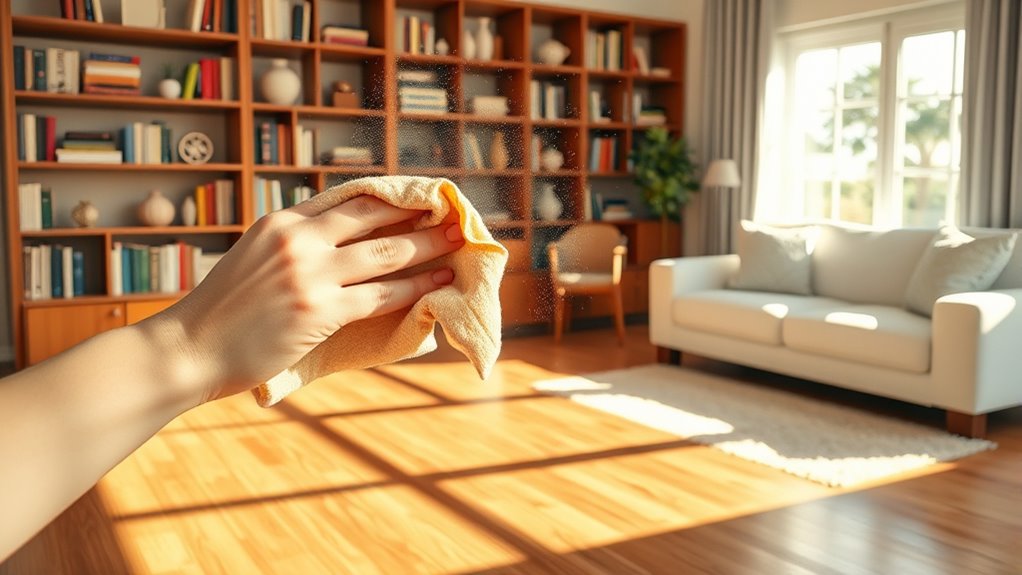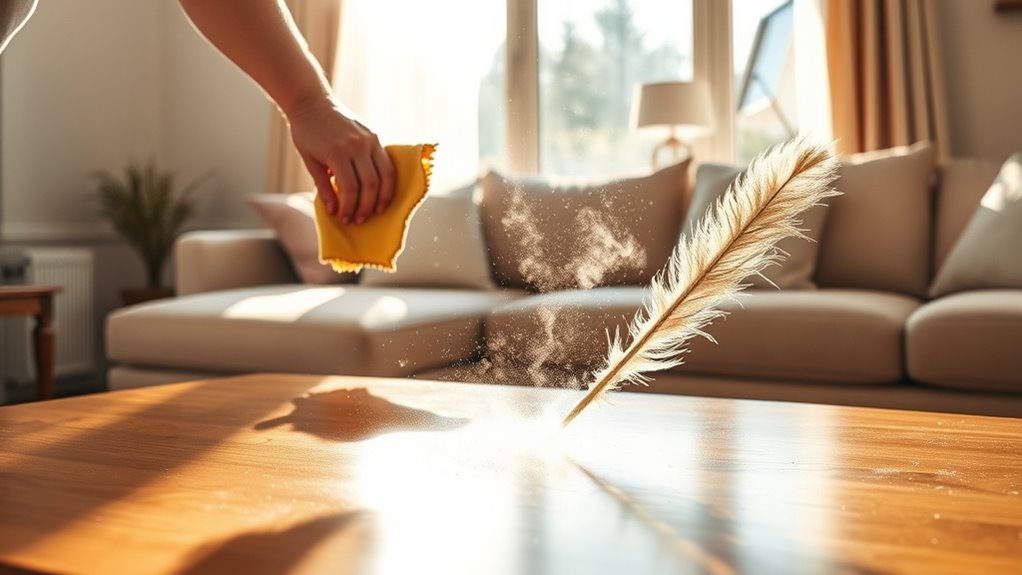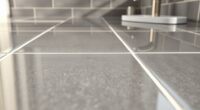To avoid dusting wrong, start with the right tools like electrostatic dusters that attract dust, rather than spreading it around. Dust from top to bottom, focusing on ceilings, fans, and shelves, then move downward to furniture and baseboards. Use damp microfiber cloths instead of dry ones to trap more dust. Regularly clean and maintain your tools to stay effective. Keep these tips in mind, and you’ll uncover more ways to achieve a truly dust-free home.
Key Takeaways
- Use electrostatic dusters to attract and remove dust effectively without spreading particles around.
- Dust from top to bottom, starting with ceiling fans and fixtures, to prevent re-depositing dust on cleaned surfaces.
- Switch to damp microfiber cloths instead of dry ones for better dust trapping and cleaner results.
- Regularly clean and maintain your dusting tools to keep them effective and prevent spreading allergens.
- Incorporate natural remedies like vinegar and essential oils into your routine for eco-friendly, effective dust control.

Keeping your home dust-free can feel like an endless task, but with the right dusting techniques, you can make it more manageable. One of the most effective tools you can use is an electrostatic duster. Unlike traditional cloths, electrostatic dusters generate static electricity that attracts dust particles, pulling them off surfaces without spreading them around. This means less time spent wiping repeatedly and more thorough cleaning in fewer passes. When you use an electrostatic duster, you’re not just moving dust from one surface to another; you’re capturing it, which results in a cleaner, healthier environment. Remember to gently sweep over surfaces, paying attention to corners, vents, and hard-to-reach areas, where dust tends to accumulate. Regularly cleaning and maintaining your dusting tools ensures their effectiveness and prevents the spread of allergens.
Use an electrostatic duster for quick, thorough, and dust-free cleaning of hard-to-reach areas.
In addition to using the right tools, incorporating natural cleaning remedies into your routine can boost your dusting effectiveness. For example, a mixture of vinegar and water works wonders for cleaning surfaces and breaking down dust buildup. Vinegar is a natural disinfectant that doesn’t leave behind harsh chemicals, making it safer for your family and pets. You can also add a few drops of essential oils like lemon or eucalyptus to your cleaning solution for a fresh scent and added antimicrobial benefits. Using natural remedies not only reduces exposure to synthetic chemicals but also helps you maintain a more eco-friendly home. Understanding dust and how it accumulates can help you target problem areas more effectively.
Another tip is to dust from top to bottom. Start with high surfaces like ceiling fans, light fixtures, and shelves, then work your way down to furniture and baseboards. This way, any dust that falls will be cleaned up later, preventing you from spreading dust around again. When dusting, avoid dry cloths that just move dust around; instead, opt for slightly damp microfiber cloths or electrostatic dusters, which trap dust particles efficiently. Regularly washing or replacing your cloths ensures they remain effective in capturing dust and won’t harbor bacteria or allergens.
Finally, consistency is key. Make dusting a weekly habit to prevent buildup and surface clutter. Incorporate natural cleaning remedies into your routine, and invest in a quality electrostatic duster to make the task easier. With these tips, dusting doesn’t have to be a dreaded chore. Instead, it becomes a simple, manageable part of your cleaning routine that keeps your home healthier and looking its best. By using the right tools and natural solutions, you’ll reduce allergens, improve air quality, and enjoy a cleaner, dust-free space every day.
Frequently Asked Questions
How Often Should I Dust My Entire House?
You should dust your entire house at least once a week, but your dusting schedule depends on dust accumulation rates in your home. High-traffic areas or homes with pets may need more frequent dusting, maybe twice a week. Regular dusting prevents buildup and keeps your home healthier. Pay special attention to surfaces that attract dust, and adjust your routine as needed to maintain a clean, dust-free environment.
What Are the Best Eco-Friendly Dusting Products?
You might think synthetic products are your only option, but natural ingredients and biodegradable options are actually your best eco-friendly dusting products. They effectively trap dust without harmful chemicals, making your home safer and greener. Look for plant-based sprays or homemade solutions with vinegar and essential oils. These eco-friendly options not only clean well but also help reduce your carbon footprint, proving that greener choices are often the most effective.
Can I Use Microfiber Cloths on Electronic Screens?
You can definitely use microfiber cloths on electronic screens, but prioritize microfiber safety by choosing lint-free, soft cloths. Follow screen cleaning tips by lightly dampening the cloth with water or a screen-safe cleaner, avoiding harsh chemicals. Gently wipe the surface in circular motions to prevent scratches and streaks. This method keeps your screens clean without damage, making microfiber cloths an effective tool for safe, streak-free screen cleaning.
Is It Necessary to Dust Ceiling Fans Regularly?
Think of your ceiling fan blades as the silent guardians of your comfort—neglect them, and dust will linger like an unwelcome guest. Regular ceiling fan maintenance is essential, so dust those blades often to prevent buildup. Not only does this keep the air cleaner, but it also prolongs the fan’s lifespan. Skipping routine dusting can lead to inefficient operation and unnecessary wear—so stay proactive and keep your fan blades spotless!
How Do I Remove Dust From Delicate or Antique Items?
To remove dust from delicate or antique items, you should handle fragile item cleaning with extra care. Use a soft, lint-free cloth or a gentle brush to carefully wipe surfaces without applying too much pressure. For antique preservation, avoid harsh chemicals and opt for a slightly damp cloth if needed. Regular, gentle dusting helps maintain the item’s integrity without causing damage, ensuring your treasured pieces stay beautiful for years to come.
Conclusion
Remember, thorough dusting isn’t just about quick swipes; it’s about methodically tackling every surface. Some might think it’s too time-consuming, but a little effort regularly keeps dust at bay and improves your home’s air quality. Don’t skip areas or rush through it—you’ll save yourself from more extensive cleaning later. With consistent, proper techniques, you can enjoy a truly dust-free home without feeling overwhelmed. Your efforts will pay off in a cleaner, healthier living space.










